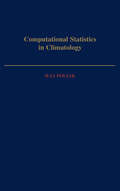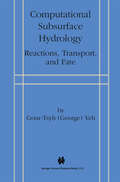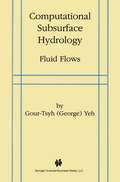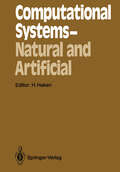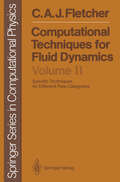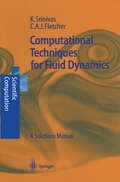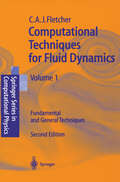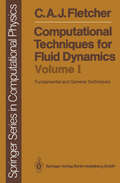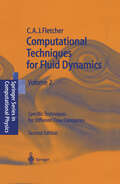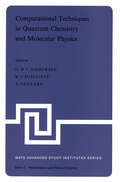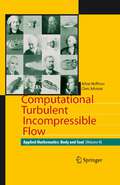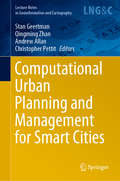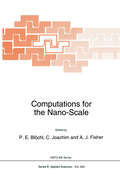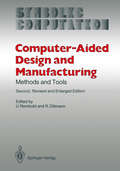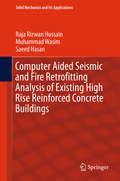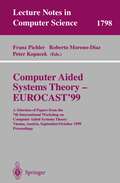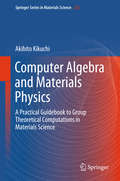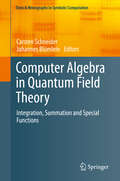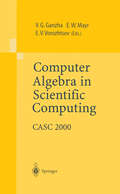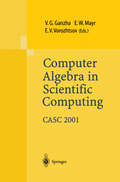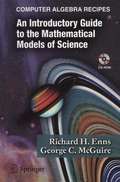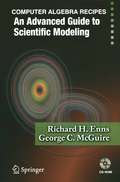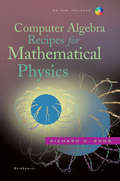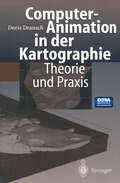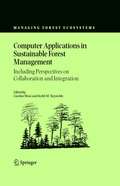- Table View
- List View
Computational Subsurface Hydrology: Reactions, Transport, and Fate
by Gour-Tsyh (George) YehAny numerical subsurface model is comprised of three components: a theoretical basis to translate our understanding phenomena into partial differential equations and boundary conditions, a numerical method to approximate these governing equations and implement the boundary conditions, and a computer implementation to generate a generic code for research as well as for practical applications. Computational Subsurface Hydrology: Reactions, Transport, and Fate is organized around these themes. The fundamental processes occurring in subsurface media are rigorously integrated into governing equations using the Reynolds transport theorem and interactions of these processes with the surrounding media are sophisticatedly cast into various types of boundary conditions using physical reasoning. A variety of numerical methods to deal with reactive chemical transport are covered in Computational Subsurface Hydrology: Reactions, Transport, and Fate with a particular emphasis on the adaptive local grid refinement and peak capture using the Lagrangian-Eulerian approach. The topics on coupled fluid flows and reactive chemical transport are unique contributions of this book. They serve as a reference for research as well as for practical applications with a computer code that can be purchased from the author. Four computer codes to simulate vertically integrated horizontal solute transport (LEMA), contaminant transport in moving phreatic aquifers in three dimensions (3DLEMA), solute transport in variably saturated flows in two dimensions (LEWASTE), and solute transport under variably saturated flows in three dimensions (3DLEWASTE) are covered. These four computer codes are designed for generic applications to both research and practical problems. They could be used to simulate most of the practical, real-world field problems. Reactive chemical transport and its coupling with fluid flows are unique features in this book. Theories, numerical implementations, and example problems of coupled reactive transport and flows in variably saturated media are presented. A generic computer code, HYDROGEOCHEM 3.0, is developed. A total of eight example problems are used to illustrate the application of the computational model. These problems are intended to serve as examples for setting up a variety of simulations that one may encounter in research and field-site applications. Computational Subsurface Hydrology: Reactions, Transport, and Fate offers practicing engineers and scientists a theoretical background, numerical methods, and computer codes for modeling contaminant transport in subsurface media. It also serves as a textbook for senior and graduate course on reactive chemical transport in subsurface media in disciplines such as civil and environmental engineering, agricultural engineering, geosciences, soil sciences, and chemical engineering. Computational Subsurface Hydrology: Reactions, Transport, and Fate presents a systematic derivation of governing equations and boundary conditions of subsurface contaminant transport as well as reaction-based geochemical and biochemical processes. It discusses a variety of numerical methods for moving sharp-front problems, expounds detail procedures of constructing Lagrangian-Eulerian finite element methods, and describes precise implementation of computer codes as they are applied to subsurface contaminant transport and biogeochemical reactions.
Computational Subsurface Hydrology: Fluid Flows
by Yeh Gour-TsyhComputational Subsurface Hydrology: Fluid Flows offers practicing engineers and scientists a theoretical background, numerical methods, and computer codes for the modeling of fluid flows in subsurface media. It will also serve as a text for senior and graduate courses on fluid flows in subsurface media in disciplines such as civil and environmental engineering, agricultural engineering, geosciences, soil sciences, and chemical engineering. Computational Subsurface Hydrology: Fluid Flows presents a systematic derivation of governing equations and boundary conditions of subsurface fluid flow. It discusses a variety of numerical methods, expounds detailed procedures for constructing finite element methods, and describes precise implementation of computer codes as they are applied to subsurface flows. Four computer codes to simulate vertically integrated horizontal flows (FEWA), saturated flows with moving phreatic surfaces in three dimensions (3DFEWA), variably saturated flows in two dimensions (FEMWATER), and variable flows in three dimensions (3DFEMWATER) are attached to this book. These four computer codes are designed for generic applications to both research and practical problems. They could be used to simulate most of the practical, real-world field problems. If you would like a copy of the diskettes containing the four, basic general purpose computer codes referred to in Computational Subsurface Hydrology: Fluid Flows, please email Gour-Tsyh Yeh at the following address : gyeh@mail.ucf.edu
Computational Systems — Natural and Artificial: Proceedings of the International Symposium on Synergetics at Schloß Elmau, Bavaria, May 4–9, 1987 (Springer Series in Synergetics #38)
by Hermann HakenThis book contains the invited papers presented at an international sympo sium held at Schloss Elmau, Bavaria (FRG), May 4-9, 1987. Leading experts from neurobiology, medicine, physics, and the computer sciences joined to gether to present and discuss their most recent results. A particular example of the natural computational systems discussed is the visual system of man and animals. A bridge between neural networks and physical systems is provided by spin glass models of neural networks, which were also treated. Concrete realizations of new kinds of devices in microelectronics were among the further topics, as were general problems on the calculation of chaotic orbits. In this way these proceedings present a number of quite recent ap proaches to problems which are of great current interest in fields concerned with computational systems. Bringing together scientists from neurobiology, physics, and the computer sciences has been one of the main aims of the synergetics enterprise, and in particular of its international symposia, from the very beginning. For exam ple, its first meeting held in 1972 at Schloss Elmau included, among others, papers by R. Landauer and J. W. F. Woo on cooperative phenomena in data processing, by W. Reichardt on mechanisms of pattern recognition by the visual system of insects, by B. Julesz on stereoscopic depth perception, and by H. R. Wilson on cooperative phenomena in a homogeneous cortical tissue model. Whole meetings and the corresponding proceedings were devoted to these problems, e. g.
Computational Techniques for Fluid Dynamics: Specific Techniques for Different Flow Categories (Springer Series in Computational Physics)
by Clive A. FletcherAs indicated in Vol. 1, the purpose of this two-volume textbook is to pro vide students of engineering, science and applied mathematics with the spe cific techniques, and the framework to develop skill in using them, that have proven effective in the various branches of computational fluid dy namics Volume 1 describes both fundamental and general techniques that are relevant to all branches of fluid flow. This volume contains specific tech niques applicable to the different categories of engineering flow behaviour, many of which are also appropriate to convective heat transfer. The contents of Vol. 2 are suitable for specialised graduate courses in the engineering computational fluid dynamics (CFD) area and are also aimed at the established research worker or practitioner who has already gained some fundamental CFD background. It is assumed that the reader is famil iar with the contents of Vol. 1. The contents of Vol. 2 are arranged in the following way: Chapter 11 de velops and discusses the equations governing fluid flow and introduces the simpler flow categories for which specific computational techniques are considered in Chaps. 14-18. Most practical problems involve computational domain boundaries that do not conveniently coincide with coordinate lines. Consequently, in Chap. 12 the governing equations are expressed in generalised curvilinear coordinates for use in arbitrary computational domains. The corresponding problem of generating an interior grid is considered in Chap. 13.
Computational Techniques for Fluid Dynamics: A Solutions Manual (Scientific Computation)
by Karkenahalli Srinivas Clive A.J. FletcherThis complementary text provides detailed solutions for the problems that appear in Chapters 2 to 18 of Computational Techniques for Fluid Dynamics (CTFD), Second Edition. Consequently there is no Chapter 1 in this solutions manual. The solutions are indicated in enough detail for the serious reader to have little difficulty in completing any intermediate steps. Many of the problems require the reader to write a computer program to obtain the solution. Tabulated data, from computer output, are included where appropriate and coding enhancements to the programs provided in CTFD are indicated in the solutions. In some instances completely new programs have been written and the listing forms part of the solution. All of the program modifications, new programs and input/output files are available on an IBM compatible floppy direct from C.A.J. Fletcher. Many of the problems are substantial enough to be considered mini-projects and the discussion is aimed as much at encouraging the reader to explore ex tensions and what-if scenarios leading to further dcvelopment as at providing neatly packaged solutions. Indeed, in order to givc the reader a better intro duction to CFD reality, not all the problems do have a "happy ending". Some suggested extensions fail; but the reasons for the failure are illuminating.
Computational Techniques for Fluid Dynamics 1: Fundamental and General Techniques (Scientific Computation)
by Clive A.J. FletcherThis well-known 2-volume textbook provides senior undergraduate and postgraduate engineers, scientists and applied mathematicians with the specific techniques, and the framework to develop skills in using the techniques in the various branches of computational fluid dynamics. A solutions manual to the exercises is in preparation.
Computational Techniques for Fluid Dynamics 1: Fundamental and General Techniques (Springer Series in Computational Physics)
by Clive A.J. FletcherThe purpose of this two-volume textbook is to provide students of engineer ing, science and applied mathematics with the specific techniques, and the framework to develop skill in using them, that have proven effective in the various branches of computational fluid dynamics (CFD). Volume 1 de scribes both fundamental and general techniques that are relevant to all branches of fluid flow. Volume 2 provides specific techniques, applicable to the different categories of engineering flow behaviour, many of which are also appropriate to convective heat transfer. An underlying theme of the text ist that the competing formulations which are suitable for computational fluid dynamics, e.g. the finite differ ence, finite element, finite volume and spectral methods, are closely related and can be interpreted as part of a unified structure. Classroom experience indicates that this approach assists, considerably, the student in acquiring a deeper understanding of the strengths and weaknesses of the alternative computational methods. Through the provision of 24 computer programs and associated exam ples and problems, the present text is also suitable for established research workers and practitioners who wish to acquire computational skills without the benefit of formal instruction. The text includes the most up-to-date techniques and is supported by more than 300 figures and 500 references.
Computational Techniques for Fluid Dynamics 2: Specific Techniques for Different Flow Categories (Scientific Computation)
by Clive A.J. FletcherThe purpose and organisation of this book are described in the preface to the first edition (1988). In preparing this edition minor changes have been made, par ticularly to Chap. 1 (Vol. 1) to keep it reasonably current, and to upgrade the treatment of specific techniques, particularly in Chaps. 12-14 and 16-18. How ever, the rest of the book (Vols. 1 and 2) has required only minor modification to clarify the presentation and to modify or replace individual problems to make them more effective. The answers to the problems are available in Solutions Manual jor Computational Techniques jor Fluid Dynamics by K. Srinivas and C. A. J. Fletcher, published by Springer-Verlag, Heidelberg, 1991. The computer programs have also been reviewed and tidied up. These are available on an IBM compatible floppy disc direct from the author. I would like to take this opportunity to thank the many readers for their usually generous comments about the first edition and particularly those readers who went to the trouble of drawing specific errors to my attention. In this revised edi tion considerable effort has been made to remove a number of minor errors that had found their way into the original. I express the hope that no errors remain but welcome communication that will help me improve future editions. In preparing this revised edition I have received considerable help from Dr. K.
Computational Techniques in Quantum Chemistry and Molecular Physics: Proceedings of the NATO Advanced Study Institute held at Ramsau, Germany, 4–21 September, 1974 (Nato Science Series C: #15)
by Geerd H. F. Diercksen B. T. Sutcliffe A. VeillardThis book contains the transcripts of the lectures presented at the NATO Advanced study Institute on "Computational Techniques in Quantum Chemistry and Molecular Physics", held at Ramsau, Germany, 4th - 21st Sept. 1974. Quantum theory was developed in the early decades of this century and was first applied to problems in chemistry and molecular physics as early as 1927. It soon emerged however, that it was impossible to con sider any but the simplest systems in any quantita tive detail because of the complexity of Schrodinger's equation which is the basic equation for chemical and molecular physics applications. This remained the si tuation until the development, after 1950, of elec tronic digital computers. It then became possible to attempt approximate solutions of Schrodinger's equa tion for fairly complicated systems, to yield results which were sufficiently accurate to make comparison with experiment meaningful. Starting in the early nineteen sixties in the United States at a few centres with access to good computers an enormous amount of work went into the development and implementation of schemes for approximate solu tions of Schrodinger's equation, particularly the de velopment of the Hartree-Fock self-consistent-field scheme. But it was soon found that the integrals needed for application of the methods to molecular problems are far from trivial to evaluate and cannot be easily approximated.
Computational Turbulent Incompressible Flow: Applied Mathematics: Body and Soul 4
by Johan Hoffman Claes JohnsonThis is Volume 4 of the book series of the Body and Soul mathematics education reform program. It presents a unified new approach to computational simulation of turbulent flow starting from the general basis of calculus and linear algebra of Vol 1-3. The book puts the Body and Soul computational finite element methodology in the form of General Galerkin (G2) up against the challenge of computing turbulent solutions of the inviscid Euler equations and the Navier-Stokes equations with small viscosity. This is an outstanding textbook presenting plenty of new material with an excellent pedagogical approach.
Computational Urban Planning and Management for Smart Cities (Lecture Notes in Geoinformation and Cartography)
by Stan Geertman Andrew Allan Qingming Zhan Christopher PettitThis book contains a selection of the best articles presented at the CUPUM (Computational Urban Planning and Urban Management) conference, held in the second week of July 2019 at the University of Wuhan, China. The chapters included were selected based on a double-blind review process involving external reviewers.
Computations for the Nano-Scale (NATO Science Series E: #240)
by P. E. Blöchl C. Joachim A. J. FisherProceedings of the NATO Advanced Research Workshop, Aspet, France, October 12-16, 1992
Computer-Aided Design and Manufacturing: Methods and Tools (Symbolic Computation)
by U. Rembold R. DillmannManufacturing contributes to over 60 % of the gross national product of the highly industrialized nations of Europe. The advances in mechanization and automation in manufacturing of international competitors are seriously challenging the market position of the European countries in different areas. Thus it becomes necessary to increase significantly the productivity of European industry. This has prompted many governments to support the development of new automation resources. Good engineers are also needed to develop the required automation tools and to apply these to manufacturing. It is the purpose ofthis book to discuss new research results in manufacturing with engineers who face the challenge of building tomor row's factories. Early automation efforts were centered around mechanical gear-and-cam technology and hardwired electrical control circuits. Because of the decreasing life cycle of most new products and the enormous model diversification, factories cannot be automated efficiently any more by these conventional technologies. With the digital computer, its fast calculation speed and large memory capacity, a new tool was created which can substantially improve the productivity of manufactur ing processes. The computer can directly control production and quality assurance functions and adapt itself quickly to changing customer orders and new products.
Computer Aided Seismic and Fire Retrofitting Analysis of Existing High Rise Reinforced Concrete Buildings (Solid Mechanics and Its Applications #222)
by Raja Rizwan Hussain Muhammad Wasim Saeed HasanThis book details the analysis and design of high rise buildings for gravity and seismic analysis. It provides the knowledge structural engineers need to retrofit existing structures in order to meet safety requirements and better prevent potential damage from such disasters as earthquakes and fires.Coverage includes actual case studies of existing buildings, reviews of current knowledge for damages and their mitigation, protective design technologies, and analytical and computational techniques. This monograph also provides an experimental investigation on the properties of fiber reinforced concrete that consists of natural fibres like coconut coir and also steel fibres that are used for comparison in both Normal Strength Concrete (NSC) and High Strength Concrete (HSC). In addition, the authors examine the use of various repair techniques for damaged high rise buildings. The book will help upcoming structural design engineers learn the computer aided analysis and design of real existing high rise buildings by using ACI code for application of the gravity loads, UBC- 97 for seismic analysis and retrofitting analysis by computer models. It will be of immense use to the student community, academicians, consultants and practicing professional engineers and scientists involved in the planning, design, execution, inspection and supervision for the proper retrofitting of buildings.
Computer Aided Systems Theory - EUROCAST'99: A Selection of Papers from the 7th International Workshop on Computer Aided Systems Theory Vienna, Austria, September 29 - October 2, 1999 Proceedings (Lecture Notes in Computer Science #1798)
by Franz Pichler Roberto Moreno-Diaz Peter KopacekComputer Aided Systems Theory (CAST) deals with the task of contributing to the creation and implementation of tools for the support of usual CAD tools for design and simulation by formal mathematical or logical means in modeling. Naturally,thebasisfortheconstructionandimplementationofCASTsoftwareis provided by the existing current knowledge in modeling and by the experience of practitioners in engineering design. Systems Theory, as seen from the viewpoint of CAST research and CAST tool development, has the role of providing formal frameworks and related theoretical knowledge for model-construction and model analysis. We purposely do not distinguish sharply between systems theory and CAST and other similar ?elds of research and tool development such as for example in applied numerical analysis or other computational sciences. TheheredocumentedEUROCASTconferencewhichtookplaceattheVienna University of Technology re?ects current mainstreams in CAST. As in the p- vious conferences new topics, both theoretical and application oriented, have been addressed. The presented papers show that the ?eld is widespread and that new - velopments in computer science and in information technology are the driving forces. Theeditorswouldliketothanktheauthorsforprovidingtheirmanuscriptsin hardcopyandinelectronicformontime.Thesta?ofSpringer-VerlagHeidelberg gave, as in previous CAST publications, valuable support in editing this volume.
Computer Algebra and Materials Physics: A Practical Guidebook to Group Theoretical Computations in Materials Science (Springer Series in Materials Science #272)
by Akihito KikuchiThis book is intended as an introductory lecture in material physics, in which the modern computational group theory and the electronic structure calculation are in collaboration.The first part explains how to use computer algebra for applications in solid-state simulation, based on the GAP computer algebra package. Computer algebra enables us to easily obtain various group theoretical properties, such as the representations, character tables, and subgroups. Furthermore it offers a new perspective on material design, which could be executed in a mathematically rigorous and systematic way.The second part then analyzes the relation between the structural symmetry and the electronic structure in C60 (as an example of a system without periodicity). The principal object of the study was to illustrate the hierarchical change in the quantum-physical properties of the molecule, which correlates to the reduction in the symmetry (as it descends down in the ladder of subgroups).The book also presents the computation of the vibrational modes of the C60 by means of the computer algebra. In order to serve the common interests of researchers, the details of the computations (the required initial data and the small programs developed for the purpose) are explained in as much detail as possible.
Computer Algebra in Quantum Field Theory: Integration, Summation and Special Functions (Texts & Monographs in Symbolic Computation)
by Carsten Schneider and Johannes BlümleinThe book focuses on advanced computer algebra methods and special functions that have striking applications in the context of quantum field theory. It presents the state of the art and new methods for (infinite) multiple sums, multiple integrals, in particular Feynman integrals, difference and differential equations in the format of survey articles. The presented techniques emerge from interdisciplinary fields: mathematics, computer science and theoretical physics; the articles are written by mathematicians and physicists with the goal that both groups can learn from the other field, including most recent developments. Besides that, the collection of articles also serves as an up-to-date handbook of available algorithms/software that are commonly used or might be useful in the fields of mathematics, physics or other sciences.
Computer Algebra in Scientific Computing: CASC 2000
by Viktor G. Ganzha Ernst W. Mayr Evgenii V. VorozhtsovProceedings of the Third Workshop on Computer Algebra in Scientific Computing, Samarkand, Octobe5r 5-9, 2000
Computer Algebra in Scientific Computing CASC 2001: Proceedings of the Fourth International Workshop on Computer Algebra in Scientific Computing, Konstanz, Sept. 22-26, 2001
by Viktor G. Ganzha Ernst W. Mayr Evgenii V. VorozhtsovCASC 2001 continues a tradition ~ started in 1998 ~ of international con ferences on the latest advances in the application of computer algebra systems to the solution of various problems in scientific computing. The three ear (CASs) lier conferences in this sequence, CASC'98, CASC'99, and CASC 2000, were held, Petersburg, Russia, in Munich, Germany, and in Samarkand, respectively, in St. Uzbekistan, and proved to be very successful. We have to thank the program committee, listed overleaf, for a tremendous job in soliciting and providing reviews for the submitted papers. There were more than three reviews per submission on average. The result of this job is reflected in the present volume, which contains revised versions of the accepted papers. The collection of papers included in the proceedings covers various topics of computer algebra methods, algorithms and software applied to scientific computing. In particular, five papers are devoted to the implementation of the analysis of involutive systems with the aid of CASso The specific examples include new efficient algorithms for the computation of Janet bases for monomial ideals, involutive division, involutive reduction method, etc. A number of papers deal with application of CASs for obtaining and vali dating new exact solutions to initial and boundary value problems for partial differential equations in mathematical physics. Several papers show how CASs can be used to obtain analytic solutions of initial and boundary value problems for ordinary differential equations and for studying their properties.
Computer Algebra Recipes: An Introductory Guide to the Mathematical Models of Science
by Richard H. Enns George C. McGuire* Contains computer algebra worksheets or "recipes" designed using MAPLE (System 10); no prior knowledge of MAPLE is assumed* Effective computational science text for first- and second-year undergraduates in mathematics, physics, engineering, chemistry, economics, biology, and pre-medicine* Examples and problems provide basis for both self-study and on-line course
Computer Algebra Recipes: An Advanced Guide to Scientific Modeling
by Richard H. Enns George C. McGuireThis book presents a large number of computer algebra worksheets or "recipes" that have been designed using MAPLE to provide tools for problem solving and to stimulate critical thinking. No prior knowledge of MAPLE is necessary. All relevant commands are introduced on a need-to-know basis and are indexed for easy reference. Each recipe features a scientific model or method and an interesting or amusing story designed to both entertain and enhance concept comprehension and retention.
Computer Algebra Recipes for Mathematical Physics
by Richard H. Enns* Uses a pedagogical approach that makes a mathematically challenging subject easier and more fun to learn* Self-contained and standalone text that may be used in the classroom, for an online course, for self-study, as a reference* Using MAPLE allows the reader to easily and quickly change the models and parameters
Computer-Animation in der Kartographie: Theorie und Praxis
by Doris DranschDie Entwicklungen der Computer-Kartographie zielten bisher vor allem darauf ab, die Computertechnik so zu verbessern, daß die Computer-Karte immer mehr der Qualität der Papier-Karte angepasst werden konnte. Computer bieten jedoch weitaus größere Möglichkeiten für die kartographische Informationsdarstellung. Sie bieten ein neues Medium, das Information dynamisch und interaktiv wiedergeben kann, und sie bieten eine neue Technik, welche die schnelle und damit variable Darstellung räumlicher Information ermöglicht. Dieses Potential wird hier aufgezeigt und für die Kartographie nutzbar gemacht. Dazu wird ein Teilbereich der computergestützten Visualisierung, die Computer-Animation, daraufhin untersucht, wie sie für eine verbesserte kartographische Informationsdarstellung genutzt werden kann.
Computer Applications in Sustainable Forest Management: Including Perspectives on Collaboration and Integration (Managing Forest Ecosystems #11)
by Guofan Shao Keith M. ReynoldsThis book is the most comprehensive and up-to-date treatment of computer applications in forestry. It is the first text on software for forest management to emphasize integration of computer applications. It also offers important new insights on how to continue advancing computational technologies in forest management. The authors are internationally-recognized authorities in the subjects presented.
